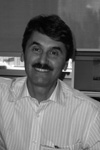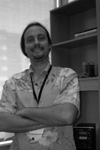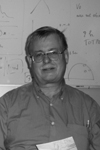principles of fluorescence techniques
may 31-june 4, 2010 | madrid, spain
Dr. Beniamino Barbieri | ISS, Inc. | President | 1602 Newton Dr. | Champaign, IL 61822 | USA | Tel: 217-359-8681 | beniamino.barbieri@iss.com
Dr. Valeria Caiolfa | CNIC | Microscopy and Dynamic Imaging | Melchor Fernández Almagro, 3 | E-28029 Madrid | Spain | Tel: +34 (91) 4531323/9; ext:2206-2207 | vcaiolfa@cnic.es
Valeria R. Caiolfa was born in Italy and received her doctorate degree in Chemistry from Ben Gurion University in Israel. She is a group leader at the Molecular Oncology Department of the San Raffaele Research Institute in Milan, Italy. Since 2008 she has been coordinating the activities of the Microscopy and Dynamic Imaging Unit at the CNIC (Fundación Centro Nacional de Investigaciones Cardiovasculares Carlos III) in Madrid, Spain.
Dr. Caiolfa's research interests are in the area of membrane receptors and cell signaling in carcinogenesis. Her current projects on GPI-anchored proteins, growth factor receptors and cytoskeleton adaptors involve the use of TIRF imaging and two-photon microscopy including FCS, PCH/N&B and FLIM for studying the protein dynamics and the signaling of multi-molecular complexes in real-time and in live cells.
Dr. Susana Sánchez Donoso | Facultad de Ciencias Químicas | Departmento de Polimeros | Universidad de Concepción | Concepción, Chile | susanchez@udec.cl
Susana Sánchez was born in Chile and received her doctorate degree in Chemistry from the Catholic University of Valparaiso. In 1997, she joined the Laboratory for Fluorescence Dynamics (LFD) at the University of Illinois at Urbana-Champaign as a post doctoral fellow and become the User Coordinator in 2001. In 2006 she moved with the LFD to the University of California at Irvine as an Independent Researcher and the User Coordinator of the LFD. Since 2013 she has been an Assistant Professor at the University of Concepción in Chile at the Polymers Department. She teaches Basic Chemistry, Biopolymers and Biological Chemstry. Dr. Sánchez's research interests are in the area of protein-protein and protein-lipid interactions. Her current projects involve the study of the role of membrane fluidity on the cholesterol removal by HDL particles from artificial systems and cells.
Prof. Enrico Gratton | University of California, Irvine | Department of Biomedical Engineering | Irvine, CA 92697-2715 | USA | Tel: 949-824-2674 | egratton22@yahoo.com
Enrico Gratton was born in Merate (Como) Italy. He received his doctorate degree in physics from the University of Rome in 1969. From 1969 to 1971 he was a post-doctoral fellow at the Istituto Superiore di Sanità in Italy. He went to the University of Illinois at Urbana-Champaign (UIUC) in 1976 and began his work as a research associate in the Department of Biochemistry. In 1978 he was appointed assistant professor in the Department of Physics at UIUC. In 1989 he was promoted to professor. Dr. Gratton's laboratory has reached international recognition for the development of instrumentation for time-resolved fluorescence spectroscopy using frequency domain methods.
In 1986 Dr. Gratton was awarded a grant from the National Institutes of Health, National Center for Research Resources, to establish the first national facility dedicated to fluorescence spectroscopy: the Laboratory for Fluorescence Dynamics (LFD). In 2006 the entire LFD laboratory moved to its current location at the new Natural Sciences II building at the University of California, Irvine. Dr. Gratton remains Principal Investigator of the LFD and holds joint appointments as Professor in the UCI departments of Biomedical Engineering and Physics and in the College of Medicine. The facility is a state-of-the-art fluorescence laboratory for use by local, national, and international scientists. It has a dual and equal commitment to research and development of fluorescence instrumentation and theory and to service in a user-oriented facility. Dr. Gratton's research interests are varied and many; they include design of new fluorescence instruments, protein dynamics, hydration of proteins, and I.R. spectroscopy of biological substances. Dr. Gratton has authored or co-authored over 400 publications in refereed scientific journals.
Dr. Christian Hellriegel | CNIC | Melchor Fernández Almagro, 3 | E-28029 Madrid | Spain | chellriegel@cnic.es
Dr. Christian Hellriegel studied chemistry at the Ludwig-Maximilians University of Munich and received his doctoral degree in Physical Chemistry on the subject of "Single Molecule Spectroscopy" in 2005 in the group of Prof. Dr. C. Bräuchle. He joined the group of Prof. Enrico Gratton at the Laboratory for Fluorescence Dynamics (LFD) at the University of California, Irvine working primarily on single-particle tracking. Since 2008 Dr. Hellriegel works as Senior Specialist and staff scientist at the CNIC. Dr. Hell is also an accomplished ukulele player and part-time graphic cartoonist.
Prof. David M. Jameson | University of Hawaii at Manoa | Department of Cell and Molecular Biology | John A. Burns School of Medicine | Honolulu, HI 96822 | USA | Tel: 808-956-5034 | Website | djameson@hawaii.edu
A student of the late Prof. Gregorio Weber, David Jameson is Full Professor in the Department of Cell and Molecular Biology at the University of Hawaii. Prof. Jameson's research interests are focused on the development and application of time-resolved and steady-state fluorescence methodologies to elucidate dynamic aspects of biomolecules, including proteins, nucleic acids and membrane systems.
Currently, his laboratory is investigating several protein systems, including dynamin, a large (98kDa) GTPase which functions to "pinch-off" membrane vesicles in pathways such as receptor mediated endocytosis and synaptic vesicle recycling. This research involves both in vitro and in vivo studies on the self-association modes of dynamin as well as its interaction with membranes and other proteins such as endophilin and Arc. His lab also has a project on Botulinum Neurotoxin funded by Allergan, Inc. This project involves biophysical studies on proteins forming the neurotoxin complex as well as development of in vitro and in vivo toxin assays based on fluorescence fluctuation spectroscopy.
Author of more than 130 peer-reviewed articles, Prof. Jameson regularly reviews grants for the American Heart Association, the National Institutes of Health and the National Science Foundation. His research has been supported by grants from the National Institutes of Health, the National Science Foundation and the American Heart Association.
Prof. Dr. Martin vandeVen | Hasselt University and School of Life Sciences | Transnationale Universiteit Limburg | Biomedical Research Institute | Agoralaan, Bldg. C., | B-3590-Diepenbeek | Belgium | Tel: +31-(0)11-269233/martin.vandeven@uhasselt.be | martin.vandeven@uhasselt.be
Martin vandeVen is a guest professor associated with the Biomedical Research Institute of Hasselt University and the School of Life Sciences, transnational University Limburg. Martin vandeVen obtained his Ph.D. from Utrecht University, The Netherlands in 1983, studying lipid systems using optical methods at the Biophysics department under Prof. Levine. Subsequently, he worked at Leiden University, The Netherlands, in the laboratory of Prof. Duysens on picosecond phenomena in bacterial photosynthetic systems and with Prof. Brand of John Hopkins University on the fluorescence emission from proteins. He then held a research associate position focused on instrumentation development under the guidance of Prof. Gratton at the Laboratory for Fluorescence Dynamics then located at the University of Illinois in Urbana-Champaign and now at the University of California at Irvine. At Hasselt University he continues to research confocal microscopy techniques such as FCS, FRAP and RICS on cells and tissues, auto-immune brain diseases such as multiple sclerosis and interdisciplinary development of diamond-film-based biosensors.
Dr. Moreno Zamai | CNIC | Microscopy and Dynamic Imaging | Melchor Fernández Almagro, 3 | E-28029 Madrid | Spain | Tel: +34 (91) 4531323/9; ext:2206-2207 | zamai.moreno@hsr.it
Moreno Zamai was born in Italy and received his doctorate degree in Chemistry from Ben Gurion University in Israel. He is a project leader at the Molecular Oncology Department of the San Raffaele Research Institute in Milan, Italy. Since 2009 he has also been a member of the Microscopy and Dynamic Imaging Unit at the CNIC (Fundación Centro Nacional de Investigaciones Cardiovasculares Carlos III) in Madrid, Spain.
Dr. Zamai's research interests are in the area of molecular dynamics of proteins, protein-protein interaction, binding kinetics in vitro and in live cells using fluorescence spectroscopy and fluorescence spectro-microscopy such as FCS/PCH/N&B and FRET or time-resolved anisotropy. He is currently focused on the study of multiple signaling cascades involving the urokinase plasminogen activator receptor and on the ligand-dependent recycling and de-activation of the EGF receptor.









